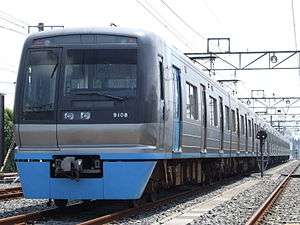Chiba New Town Railway 9100 series
| Chiba New Town Railway 9100 series | |
|---|---|
|
Set 9101, August 2008 | |
| Manufacturer | Nippon Sharyo |
| Built at | Toyokawa |
| Constructed | 1994–2000 |
| Number built | 24 vehicles (3 sets) |
| Number in service | 24 vehicles (3 sets) |
| Formation | 8 cars per trainset |
| Fleet numbers | 9101-9121 |
| Operator(s) | Chiba New Town Railway |
| Depot(s) | Inba |
| Line(s) served | Hokuso Line, Keisei Main Line, Toei Asakusa Line, Keikyu Main Line, Keikyu Airport Line |
| Specifications | |
| Car body construction | Stainless steel |
| Car length | 18,000 mm (59 ft 1 in) |
| Width | 2,780 mm (9 ft 1 in) |
| Doors | 3 pairs per side |
| Maximum speed | 120 km/h (75 mph) |
| Traction system | GTO-VVVF (TDK6172A) |
| Power output | 130 kW x 4 per motor car |
| Acceleration | 3.5 km/h/s |
| Deceleration | 4.0 km/h/s (service), 4.5 km/h/s (emergency) |
| Electric system(s) | 1,500 V DC |
| Current collection method | Overhead catenary |
| Bogies | FS-547 (motored), FS-047 (trailer) |
| Safety system(s) | ATS |
| Track gauge | 1,435 mm (4 ft 8 1⁄2 in) |
The Chiba New Town Railway 9100 series (千葉ニュータウン鉄道9100形) is a commuter electric multiple unit (EMU) train type owned by the third-sector railway company Chiba New Town Railway and operated by the Hokuso Railway on the Hokuso Line in Japan since 1994.[1] The trains are nicknamed "C-Flyer", with the "C" standing for Chiba.[1]
Operations
The 9100 series trains are used on the following lines.[1]
- Hokuso Line (Keisei-Takasago - Inba-Nihon-Idai)
- Keisei Main Line (Keisei-Takasago - Aoto)
- Keisei Oshiage Line (Aoto - Oshiage)
- Toei Asakusa Line (Oshiage - Sengakuji)
- Keikyu Main Line (Sengakuji - Keikyu Kamata)
- Keikyu Airport Line (Keikyu Kamata - Haneda Airport Domestic Terminal)
Formation
As of 1 April 2013, the fleet consists of three eight-car sets, formed as shown below, with six motored (M) cars and two trailer (T) cars, and car 1 at the southern end.[1][2]
| Car No. | 1 | 2 | 3 | 4 | 5 | 6 | 7 | 8 |
|---|---|---|---|---|---|---|---|---|
| Designation | M2c | M1 | T | M1' | M2 | T | M1 | M2c |
| Numbering | 91x8 | 91x7 | 91x6 | 91x5 | 91x4 | 91x3 | 91x2 | 91x1 |
| Weight (t) | 34.0 | 34.0 | 30.0 | 34.0 | 32.0 | 30.0 | 34.0 | 34.0 |
| Capacity (Total/seated) |
121/41 | 132/50 | 131/50 | 132/50 | 132/50 | 131/50 | 132/50 | 121/41 |
The "M1" cars each have two pantographs, and the "M1'" car has one.[2]
Interior
Passenger accommodation consists mostly of longitudinal bench seating, with some transverse seats at the car ends.[1] The end cars each have a wheelchair space.[2] The 1st-batch sets, 9101 and 9111, originally had public phones located in cars 3 and 6, but these were removed in 1997.[1]
- Interior view of car 9117, December 2009
- Transverse priority seating in car 9117, December 2009
History
The first two sets, 9101 and 9111, were built by Nippon Sharyo in Toyokawa, Aichi, and delivered in 1994, ahead of the extension of the Hokuso Line from Chiba New Town Chūō to Inzai-Makinohara in 1995.[1] A third, 2nd-batch set, 9121, was delivered in 2000, coinciding with the extension of the line from Inzai-Makinohara to Inba-Nihon-Idai.[1]
References
- 1 2 3 4 5 6 7 8 Takami, Kazuki (June 2012). "Modelers File 千葉ニュータウン鉄道9100形" [Modelers File: Chiba New Town Railway 9100 series]. Train (in Japanese). Tokyo, Japan: Presse Eisenbahn. 38 (450): 8–17.
- 1 2 3 私鉄車両編成表 2013 [Private Railway Rolling Stock Formations - 2013]. Japan: Kotsu Shimbunsha. 30 July 2013. p. 34. ISBN 978-4-330-39313-1.
External links
| Wikimedia Commons has media related to Hokuso 9100 series. |
- Nippon Sharyo 9100 series details (Japanese)
